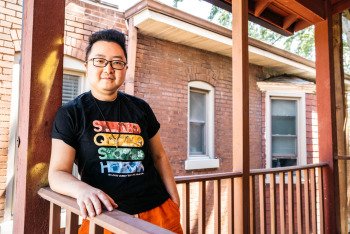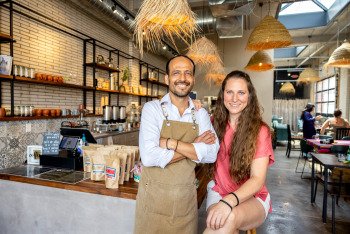Urban Oasis
Theo Smith thought he’d become an urban planner, but Kennedy Forest in Forest Park beckoned.
On a typical day in St. Louis, thousands of locals and tourists flock to Forest Park to visit animals at the Saint Louis Zoo, browse artwork in the Saint Louis Art Museum or take a paddle boat ride along the Grand Basin on Art Hill. But tucked away in the southwest corner of the nationally lauded greenspace, there’s another special area that park visitors wind through each day — Kennedy Forest, Forest Park’s first-ever area of nature conservation.
Sixty acres of untouched forestry in the middle of a city like St. Louis might seem unbelievable, but the mature hickory trees, plants and sounds of more than 200 bird species make John F. Kennedy Memorial Forest a calm retreat from the urban hustle and bustle. Dedicated in 1964 and named for the 35th U.S. President, Kennedy Forest draws interest from conservationists, bird watchers, hikers and joggers alike.
And all of them are likely to run into Theo Smith, the nature reserve technician who focuses his attention on maintaining Kennedy Forest’s natural balance. He’s a familiar face along the three and a half miles of paved and unpaved trailways within the forest, removing invasive species and nurturing the flora and fauna that claim the woods as their home.
“I do a lot of native species planting—both tree and plug form—a lot of invasive plant species removal, vegetation surveys, trail maintenance activities, working with volunteers and water quality monitoring,” Smith says. “Some days it’s like work and some days it’s really like therapy.”
It’s work that’s vital to Forest Park itself and to the daily throng of visitors who enjoy it. In awe of the majestic, 100-year-old hickories and oaks of Kennedy Forest, Smith is dedicated to preserving the city’s jewel, which regularly is noted as one of the best parks in the nation.
“I come in after work and I just sit and think — just listen to the sights and sounds. I feel fortunate and blessed to be a part of it,” he reflects. “Something that many people had hands in before, I can keep going and hopefully make better. Having this wonderful place fills me with pride and gives me a great sense of purpose.”
Conservation in Forest Park has become Smith’s passion, but he did not originally set out to work in ecology. Smith had earned his bachelor’s degree in urban affairs from Saint Louis University, studying census data, public policy and his first love: maps. Growing up in University City, Smith credits his father for sparking his love of nature, tagging along as his dad worked for the St. Louis County parks and recreation department.
“I felt like for some part of my life, I was always in this park and, in particular, in this forest,” Smith recalls. “I remember riding bikes through here with my dad years ago, not knowing how to stop and skidding down this path. But I had no idea how involved ecology could be.”
After college, Smith found himself volunteering anywhere and everywhere, including joining the Missouri Stream Team to assist in cleanup and serving with the River des Peres Watershed Coalition. Eventually, he became a nature reserve intern with Forest Park Forever and went full-time the following year.
It was a decision that cemented his calling.
“For whatever reason, I think I had a lot of trepidation,” he remembers, noting that he still didn’t have much plant knowledge at the time. “But I got in and worked my tail off and absolutely loved it. Since then, I’ve been here and they might have to catapult me out if they wanted to get rid of me.”
Smith and one other employee focus on Kennedy Forest full-time, but he relies on the help of Forest Park Forever’s 2000 volunteers to keep the 60-acres of forest in top shape, especially when invasive plants such as bush honeysuckle threaten the life of the forest.
“Just by removing the bush honeysuckle and other invasive plant species and coming in and seeding and plugging this area, you get more birds, more rodents, more chipmunks and more life. Life gives more life.”
Educating volunteers and guiding them through the planting process is one of Smith’s favorite parts about working with Forest Park Forever.
“What I’m really passionate about is planting trees,” Smith says. “It’s so fun to do, either solo or with groups of people — especially people who have not planted trees before. The look on their face, and they’re like, ‘Wow! I did it. It’s still standing. It’s here.’ And they’ll come back a year or two later and see that it’s grown this tall already.”
But there’s always room for more volunteers to help in Kennedy Forest and throughout Forest Park. In fact, Smith is counting on it.
“They think they’re just planting in the park, but they’re really kind of planting knowledge for us by sharing their time and experience,” he says of the volunteers. “The volunteers are essential to what we do. We cannot do nearly as much as we do without the help of volunteers.”
“You’ve got sweat on your face, mud on your pants, dirt in places you didn’t expect to have dirt, but you can look back on the day like, ‘Yes, I did this.’”


